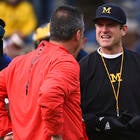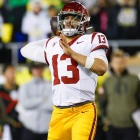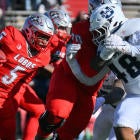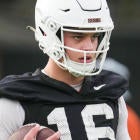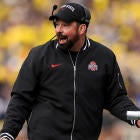The last time Ohio State and Michigan played with huge stakes for both teams was 2006 in the so-called "Game of the Century." The winner-take-all game for a spot in the BCS Championship Game was a national affair while remaining very regional on the field.
Ohio State's Heisman's Trophy quarterback, Troy Smith, was from the state of Ohio. He was protected by an all-Ohio offensive line, handed the ball off to an Ohio tailback (Antonio Pittman) and threw passes to Ohio receivers (Anthony Gonzalez, Ted Ginn Jr.) Standout pass rusher Vernon Gholston came from Michigan.
At Michigan that season, standout wide receiver Mario Manningham came from Ohio. Three-fourths of the Wolverines' starting defensive line was from Michigan. All of the starting linebackers were Ohio or Michigan natives, including star middle linebacker David Harris (Michigan).
The Midwest is how Ohio State and Michigan forever built teams. But 2016 isn't 1976. No matter how much they speak poetically about Woody vs. Bo, Urban Meyer vs. Jim Harbaugh isn't your father's Ten Year War.
On Saturday, Ohio State's quarterback from Texas ( J.T. Barrett) will throw to receivers from New York (Curtis Samuel), Texas (Dontre Wilson), Arkansas (K.J. Hill) and New Jersey (Noah Brown). Michigan will defend with a versatile future NFL player from New Jersey (Jabrill Peppers) and a cornerback from North Carolina (Channing Stribling). The Wolverines' injured quarterback from Virginia (Wilton Speight) may sit again, leaving the task to a backup out of Pennsylvania who transferred from the University of Houston (John O'Korn).
The national reach of Meyer and Harbaugh coupled with the growth of college football and the Midwest's changing demographics has raised an unusual question. Is this the last Ohio State-Michigan game in which the majority of players are from Ohio or Michigan?
Fifty-one percent of the 2016 Ohio State and Michigan players are from those states, down from 61 percent in 2006, according to an analysis by CBS Sports. Thirty years ago, when Harbaugh (born in Ohio, partially raised in Michigan) famously delivered on his guarantee to beat the Buckeyes, 69 percent of The Game's players came from those states.
"Michigan and Ohio kids should be 50 percent of kids playing in the game, to me, because it's not just about the game," said Ted Ginn Sr., who coaches Glenville High School in inner-city Cleveland and has sent numerous players to Ohio State and Michigan. "It's about your community, your state, but you have to develop to play on those levels as well. Nobody's just going to give you something. [Meyer and Harbaugh] are going where they can get players. You can't blame them for that."
| Players in 'The Game' from Ohio or Michigan | |||
| Year | Ohio Players | Michigan Players | Total |
| 2016 | 31% | 20% | 51% |
| 2006 | 39% | 22% | 61% |
| 1996 | 36% | 24% | 60% |
| 1986 | 47% | 22% | 69% |
| 1976 | 41% | 27% | 68% |
| 1966 | 45% | 37% | 83% |
Over the past 10 years, the population of Ohio increased only 1 percent and Michigan declined 2 percent. As manufacturing and working-class jobs disappeared, other traditional Big Ten footprint states didn't make large population gains, either: Illinois (no change), Pennsylvania (up 3 percent), Wisconsin (up 4 percent) and Indiana (up 5 percent).
In 1996, Ohio had 11.2 million people and Michigan 9.6 million, making them larger than Georgia (7.4 million) and North Carolina (7.3 million) and not terribly far behind Florida (14.4 million). Today, Michigan (9.9 million) has fewer people than Georgia (10.3 million) and North Carolina (10.1 million). Ohio (11.6 million) is closer in population to Nebraska (1.9 million) than to Florida (20.6 million).
"Where the job goes, the money goes. Where the money goes, the population goes," said author John Bacon, who has written about Michigan football and closely followed the Wolverines-Buckeyes rivalry for decades. "The population is all going South and West. [Nick] Saban is not having to go very far to get what he wants. He's definitely not picking the pocket of Michigan and Ohio to win championships."
The amount of Ohio State-Michigan players from the state of Michigan has never been an overwhelming number. That figure hasn't dramatically changed. Twenty percent of this year's players from both teams came from Michigan, right around where it stood in 1986 (22 percent).
Michigan has never been a large enough state for the Wolverines to rely overwhelmingly on in-state players. Bo Schembechler used to bank a lot on Chicago. Illinois was the No. 3 state for Schembechler after Ohio and Michigan, comprising 15 percent of his team in 1976 and 9 percent in 1986.
Today, 5 percent of Michigan's players are from Illinois. That's the same amount as California and fewer than Florida and New Jersey.
"That's a seismic shift and shows you how the game is changing," Bacon said. "Think of how much you have to invest to get a kid's attention in L.A. when the odds are you're not going to get him. Instead of waiting for the kid to think about you, Michigan is making the kid think about you."
| Michigan in-state recruiting | ||
| Season | Players from Michigan | Number of States |
| 2016 | 37% | 26 |
| 2006 | 42% | 22 |
| 1996 | 42% | 19 |
| 1986 | 39% | 16 |
| 1976 | 45% | 13 |
| 1966 | 54% | 11 |
When Harbaugh first started satellite camps around the country in 2015, he famously said, "In my America, you're allowed to cross the state borders." He's not kidding.
Michigan's roster, recruited in part by former coach Brady Hoke, has players from 26 states. The broad reach of Michigan and Harbaugh isn't going away.
According to 247Sports, Harbaugh has 2017 commitments so far from 20 players across Michigan, Ohio, Colorado, Virginia, Florida, New Mexico, Pennsylvania, Massachusetts, Alabama, Connecticut, Georgia, Rhode Island and Montreal, Quebec. Michigan has more commitments from players in Connecticut (three) than Ohio (two).
"I don't even know if there are regions Michigan is focusing on," said Barton Simmons, director of scouting for 247Sports. "Urban Meyer was focused on Florida and the Southeast early on, but with Michigan, they're taking an approach that Michigan is nation-wide and they're going to look for players anywhere they can find them. There's only a few schools that can do that."
Simmons said Harbaugh's approach carries risks of possibly misevaluating recruits and losing some footing locally. "But those can be easily remedied in the next class, and they're easily forgiven if you're winning a lot of football games," he said.
Where the Ohio State-Michigan game really has lost local players resides in Ohio. Ohio players make up 31 percent of this year's players in The Game, down from 39 percent in 2006 and from well over 40 percent between the 1960s and 1980s.
When No. 1 Ohio State beat No. 2 Michigan in 2006, 46 percent of both teams' starters came from Ohio. This week, it's projected that approximately 37 percent of the starters will be Ohio natives. The Wolverines may have as many Ohio starters as the Buckeyes, whose lineup has gone from 67 percent Ohio natives in 2006 to roughly 33 percent in 2016.
"For Ohio State, it's no longer about winning the Big Ten; it's about winning national championships," Simmons said. "Because guys are more accessible than ever around the country, it's easy to extend that net. Urban says every year at signing day, if they're ranking it, we want to win it. He recognizes who he's competing with. He's not competing with the rest of the Big Ten. He's competing with Alabama."
That's not to say Ohio lacks talented players. The state has the fifth-most players on 2016 NFL rosters.
| Ohio State in-state recruiting | ||
| Year | Players from Ohio | Number of States |
| 2016 | 55% | 20 |
| 2006 | 70% | 18 |
| 1996 | 65% | 13 |
| 1986 | 75% | 13 |
| 1976 | 67% | 16 |
| 1966 | 94% | 3 |
Some elite coaches still come out of Ohio. Meyer and Harbaugh were born in the same hospital in Toledo, Ohio -- within seven months of each other -- though Toledo isn't home for either of them. For Meyer, it's Ashtabula, Ohio; for Harbaugh, the son of a roving coach, the closest thing to home was Ann Arbor.
Harbaugh and Meyer are immersed in the history of the Michigan-Ohio State rivalry. They came of age in Bo Schembechler vs. Woody Hayes. No one would be surprised if Harbaugh vs. Meyer become the new Bo vs. Woody.
But college football has changed. No matter how often Harbaugh reminisces about Bo while wearing Woody glasses, no matter how much Meyer avoids saying "Michigan" by name, the numbers show The Game isn't just for Ohio and Michigan players anymore.
The Buckeyes now get 55 percent of their players from Ohio, down from 70 percent in 2006. Meyer likes going to the South for athletic and speedy players from warm-weather climates where football is played year-round. Ohio State has as many 2016 players from Virginia and Florida combined as it does altogether from nearby states Michigan, Illinois, Pennsylvania, Indiana, West Virginia and Wisconsin.
High school participation for 11-player football declined 2 percent nationally from 2007-15 for various reasons, including safety. While states like Alabama, Louisiana, Oklahoma and Texas have added players since then, the decline was steep for Ohio (18 percent) and Michigan (17 percent). Ohio and Michigan lost a combined 81,095 players over nine years, according to data from the National Federation of State High School Associations.
Different states have different sets of circumstances. For example, many districts in Ohio use a pay-to-participate policy for extracurricular activities, including football. The Ohio High School Athletic Association found in a 2014 survey that 46 percent of its schools had some type of pay-to-play fee, according to the Columbus Dispatch. Fees can range from nothing to $625 per sport.
At Glenville High School in inner-city Cleveland, Ginn Sr. sees a confluence of factors to explain fewer football players. Families have relocated for jobs or their child's education. The economy has taken a hit. Players don't work as hard at their sport.
From 2002-14, Ohio State signed 22 players from Glenville and at least one every year. The pipeline started with future NFL players Troy Smith, Ted Ginn Jr. and Donte Whitner and later produced Cardale Jones, who was the Buckeyes' quarterback for their latest national title in 2014. Glenville hasn't sent a scholarship player to Ohio State since 2014 or to Michigan since 2012.
"I used to regularly send players there, but those kids worked to develop and get there," Ginn Sr. said. "It wasn't just like, 'OK, let's go to Ohio State or Michigan.' ... I don't think it's just my area. I get complaints from people 1,000 miles away about the hard work and dedication it takes to do this, you know what I'm saying? When you look at the world five years ago, it was different. Today, we're losing children now."
On Saturday, more than 100,000 fans at Ohio Stadium and millions more around the country will rabidly cheer for their Buckeyes or Wolverines. For the next 365 days, these fans will live with the result of a game in which almost half of the players aren't from Ohio or Michigan.
That's the reality of Meyer (60-5 at Ohio State) vs. Harbaugh (20-4 at Michigan). That's the reality of college football's growth as the Midwest's population fell behind the South and West.
Welcome to the new reality of Ohio State vs. Michigan, where grabbing elite players from anywhere and everywhere makes the new Ten Year War look like the Two Year Sprint.












